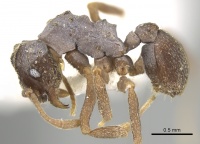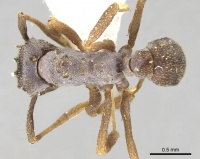Cyphomyrmex kirbyi
| Cyphomyrmex kirbyi | |
|---|---|

| |
| Scientific classification | |
| Kingdom: | Animalia |
| Phylum: | Arthropoda |
| Class: | Insecta |
| Order: | Hymenoptera |
| Family: | Formicidae |
| Subfamily: | Myrmicinae |
| Tribe: | Attini |
| Genus: | Cyphomyrmex |
| Species: | C. kirbyi |
| Binomial name | |
| Cyphomyrmex kirbyi Mayr, 1887 | |
Little is known about this rarely collected species.
Identification
See the description section below.
Distribution
Known from Columbia and Ecuador.
Latitudinal Distribution Pattern
Latitudinal Range: 9.803° to -2.1673°.
| North Temperate |
North Subtropical |
Tropical | South Subtropical |
South Temperate |
- Source: AntMaps
Distribution based on Regional Taxon Lists
Neotropical Region: Colombia (type locality), Ecuador, Venezuela.
Distribution based on AntMaps
Distribution based on AntWeb specimens
Check data from AntWeb
Countries Occupied
| Number of countries occupied by this species based on AntWiki Regional Taxon Lists. In general, fewer countries occupied indicates a narrower range, while more countries indicates a more widespread species. |

|
Estimated Abundance
| Relative abundance based on number of AntMaps records per species (this species within the purple bar). Fewer records (to the left) indicates a less abundant/encountered species while more records (to the right) indicates more abundant/encountered species. |

|
Biology
|
Castes
Nomenclature
The following information is derived from Barry Bolton's Online Catalogue of the Ants of the World.
- kirbyi. Cyphomyrmex kirbyi Mayr, 1887: 557 (w.) COLOMBIA.
- Type-material: lectotype worker (by designation of Kempf, 1966: 179), 10 paralectotype workers.
- Type-locality: lectotype Colombia (“New Grenada”): (no further data); paralectotypes with same data.
- Type-depository: NHMW.
- Santschi, 1921g: 97 (q.).
- Status as species: Dalla Torre, 1893: 150; Forel, 1905b: 158; Santschi, 1921g: 97; Emery, 1924d: 341; Weber, 1940a: 408 (in key); Kempf, 1961b: 518; Kempf, 1966: 179 (redescription); Kempf, 1972a: 92; Snelling, R.R. & Longino, 1992: 482 (in key); Bolton, 1995b: 168; Fernández & Serna, 2019: 850.
- Distribution: Colombia, Suriname.
Description
Kempf (1966) - So far, except for the aforementioned Ecuador specimens, Cyphomyrmex kirbyi is still known only from the types, hailing from an unknown locality in Colombia.
Cyphomyrmex kirbyi doubtless belongs to the rimosus-group, and differs from rimosus in the shape of the frontal lobes, absence of conspicuous parafrontal teeth on clypeus, elongate funicular segments II-IV, rather obtusely angulate infrapronotal corner, lack of midpronotal tubercles, sharper and lower meso- and epinotal ridges which never form distinctly conical tubercles, shape of hind femora which are not angulate beneath, significantly less transverse petiole, body hairs which are not squamate but simple, longer and more conspicuous.
The very long scapes and the thoracic profile reminds of Cyphomyrmex vorticis and Cyphomyrmex salvini, but kirbyi lacks the midpronotal tubercles, the prominent spine-like occipital lobes, the ventral lobe or angle on basal third of hind femora.
The Mexican Cyphomyrmex dentatus (=Cyphomyrmex flavidus) and Brazilian Cyphomyrmex peltatus agree with kirbyi in the absence of midpronotal tubercles, but differ in smaller size, more thick-set body, different shape of head, thorax, pedicel and hind femora.
Worker
Kempf (1966) - (lectotype). - Total length 3.6 (3.5-3.7) mm; head length 0.84 (0.80-0.85) mm; head width 0.77 (0.72-0.80) mm; thorax length 1.25 (1.14-1.25) mm; hind femur length 1.07 (0.99-1.09) mm. Dark reddish brown; mandibles, funiculus and legs a bit lighter, without reddish hues. Integument opaque throughout, finely, densely and indistinctly punctate-granulate. Scape reticulate-rugose. Front with a few fine, longitudinal rugulae.
Head (fig 11). Mandibles finely striolate-punctate, subopaque; chewing border with 5 teeth, a larger diastema between 2nd and 3rd basal tooth, as in rimosus and allies. Anterior border of clypeus not excised in the middle; tooth near origin of frontal lobes obsolescent. Frontal area impressed, hairless. Frontal lobes not semicircular, but somewhat angular, with an acutely rounded corner projecting in front and a more bluntly rounded corner projecting laterad. Posterior prolongation of frontal carinae sigmoidal. Carinae of vertex present, subparallel. Preocular carina curving mesad above eye. There is no postocular carina between posterior border of eye and occipital corner. Supraocular tubercle obtuse and low. Dentate occipital corner little projecting. Occipital border gently excised, a bit more deeply concave between carinae of vertex. Inferior border of cheeks marginate in its entire length. Scape in repose exceeding the occipital corner by nearly twice its maximum thickness. Funicular segments II-IV distinctly longer than broad.
Thorax (fig 17). Midpronotal tubercles absent, lateral ones well developed, each sending out foreward an ill-defined carinule separating the dorsal face from the lateral face of pronotum. Inferior pronotal corner rather obtuse and not dentate. Mesonotum with two pairs of parallel and subcontinuous longitudinal ridges, the anterior pair in profile dentiform, the posterior pair blunter. Mesoepinotal constriction deep and broad. Basal face of epinotum with a pair of sharp longitudinal ridges, their anterior and posterior ends subdentate in profile; laterally, on sides of thorax, another weaker and lower carina, which bears the epinotal spiracle. Hind femora not conspicuously broadened nor angulate beneath.
Pedicel (fig 17, 27). Petiole depressed; node not strikingly transverse but only little broader than long. Postpetiole with a deep postero-median impression, its lateral border practically immarginate.
Pilosity decumbent to appressed, not scale-like yet glistening, golden; rather long and conspicuous on gaster. Tip of tibiae and gaster with a few standing hairs.
Queen
Kempf (1966) included Santschi's (1921) description along with his own commentary:
"Long. 2,7 mm. Diffère de rimosus Mayr (sic!), par sa tête un peu plus longue, le bord postoculaire non denté. L'angle de l'épistome forme un petit lobe arrondi (lobe anguleux chez rimosus). Le bord antérieur plus arqué, les arêtes frontales moins relevées; sur un plan plus égal à celui du front. Le sillon médian du mésonotum beaucoup moins profond. Les dents de l'épinotum plus longues. Ailes un peu plus claires. Pilosité squameuse, surtout sur le gastre, qui est en outre pruineux. - Équateur: Guayaquil (Rosenberg, 1904) ouvrière et femelle. Muséum de Paris. - Ces exemplaires avaient été déterminés sous le nom de C. rimosus Mayr, par E. André, mais ils se rapportent bien mieux à la description de C. kirbyi, que je ne connais pas en nature".
I am afraid that this description is not very helpful for the recognition of isolated females. It is even doubtful whether Santschi's specimens really belong to the present species.
Type Material
Kempf (1966) - 11 workers - lectotype and paratypes - from N. Grenada (= Colombia), received on loan from the Mayr collection (NHMW).
References
- Kempf, W. W. 1966 [1965]. A revision of the Neotropical fungus-growing ants of the genus Cyphomyrmex Mayr. Part II: Group of rimosus (Spinola) (Hym., Formicidae). Stud. Entomol. 8: 161-200 (page 179, see also)
- Mayr, G. 1887. Südamerikanische Formiciden. Verh. K-K. Zool.-Bot. Ges. Wien 37: 511-632 (page 557, worker described)
- Santschi, F. 1921g. Ponerinae, Dorylinae et quelques autres formicides néotropiques. Bull. Soc. Vaudoise Sci. Nat. 54: 81-103 (page 97, queen described)
- Snelling, R. R.; Longino, J. T. 1992. Revisionary notes on the fungus-growing ants of the genus Cyphomyrmex, rimosus group (Hymenoptera: Formicidae: Attini). Pp. 479-494 in: Quintero, D., Aiello, A. (eds.) Insects of Panama and Mesoamerica: selected stu (page 485, see also)
References based on Global Ant Biodiversity Informatics
- Fernández, F. and S. Sendoya. 2004. Lista de las hormigas neotropicales. Biota Colombiana Volume 5, Number 1.
- Forel A. 1905. Miscellanea myrmécologiques II (1905). Ann. Soc. Entomol. Belg. 49: 155-185.
- Kempf W. W. 1961. A survey of the ants of the soil fauna in Surinam (Hymenoptera: Formicidae). Studia Entomologica 4: 481-524.
- Kempf, W.W. 1972. Catalago abreviado das formigas da regiao Neotropical (Hym. Formicidae) Studia Entomologica 15(1-4).
- Klingenberg, C. and C.R.F. Brandao. 2005. The type specimens of fungus growing ants, Attini (Hymenoptera, Formicidae, Myrmicinae) deposited in the Museu de Zoologia da Universidade de Sao Paulo, Brazil. Papeis Avulsos de Zoologia 45(4):41-50
- Santschi F. 1921. Ponerinae, Dorylinae et quelques autres formicides néotropiques. Bulletin de la Société Vaudoise des Sciences Naturelles 54: 81-103.




